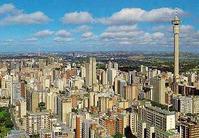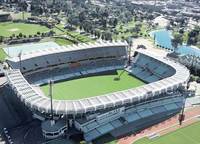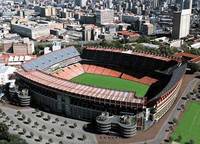
Johannesburg

Johannesburg or the City of Gold, as the city is known in South Africa, is the business hub of South Africa, contributing a substantial part of the country's GDP approximately 12%. The City is home to two of the country's most popular football teams and historical arch-rivals, Kaizer Chiefs and Orlando Pirates. Johannesburg is also known as the economic engine of Southern Africa and the trendsetter of South Africa. It is a melting pot laced with all the flavours of African cultures and beyond
Despite the hustle and bustle of the big city, Jo'burg is unexpectedly green and orientated towards outdoor living. It has a wealth of trees creating an 'urban forest', and many of the trees are located in the 2328 parks.
Cultural wealth is also in abundance, with a host of interesting museums including the Apartheid Museum, Constitution Hill and the living memory of the South Western Townships, which include the world acclaimed Soweto. The Mai Mai Market is the oldest market in Johannesburg and is a great place to discover traditional remedies. But more than that, Johannesburg has become a truly African city, melding disparate people from across the continent with the descendents of the original Tswana and Ndebele inhabitants and the European, Indian and Chinese settlers.
Today descendents of immigrants from around the world call themselves Joburgers and they are added to daily by a continual stream of migrants, keen to have some of the city's shine rub off on them.
History
The Tswana name for Johannesburg is eGoli, a place of gold. The San and Stone Age people were the first inhabitants of the area. The face of the area changed when an Australian gold prospector generated interest in the mineral wealth beneath the surface. Johannesburg became a city in 1886, during the beginning of the Witwatersrand Gold Rush.
The city also became a political hotspot during the apartheid years. Soweto was an important instrument in the liberation of South Africa. In 1955, many anti-apartheid movements met in Kliptown, Soweto to sign the Freedom Charter. The Charter enshrined the belief in equality for all. It also became the working document for the current Constitution of South Africa.
Football
A heartland of South African football, Johannesburg is the backbone of the professional game. The majority of professional clubs come from the city and its surrounds. The professional football outfits from the city are: Kaizer Chiefs, Orlando Pirates, Jomo Cosmos, BidVest Wits and one of the oldest clubs in the country, Moroka Swallows.
The city centre has been at the core of football development in South Africa. Professional football was formed in the offices of the old Rand Daily Mail newspaper in 1958. In later years, football unity talks took place at the old Rand International Hotel. Kaizer Chiefs, Orlando Pirates, Jomo Cosmos and the now defunct Highlands Park, Rangers and Lusitano have all been championship-winning clubs.
A match between Kaizer Chiefs and Orlando Pirates, which is dubbed as the ‘Soweto Derby' in South Africa, is the biggest drawcard in the country. Everytime the two meet, they attract a capacity crowd and their rivarly has been well documented throughout the decades.
Jo'burg is home to some of the country's most prized talent that include, Jomo Sono,Kaizer Motaung, Ace Ntsoelengoe, Doctor Khumalo, Lucas Radebe and many others. Sono played with Pele and Franz Beckenbauer at New York Cosmos.
Ntsoelengoe is revered as one of the greatest football players ever to be produced in South African football. He enjoyed immense success in the NASL.
The Premier League-based Wits University (now called BidVest Wit) are a team based at the University of Witwatersrand in Johannesburg. Due to their location, the team is affectionately known as the 'Clever Boys' or the ‘Students'..
Johanesburg has hosted major games before including the CAF Africa Cup of Nations, which was won by South Africa beating Tunisia 2-0 at Soccer City. The Ellis Park Stadium, situated in the heart of Johannesburg, hosted the historic 1995 Rugby World Cup where South Africa were crowned as the rugby world champions.
Soccer City

Completion:1987
Cost of construction:US$ -
Gross Capacity:94,700
One of the most artistic and awe-inspiring football venues on the African continent, the newly-reconstructed Soccer City Stadium will host the first and final matches of the 2010 FIFA World Cup South Africa™.
The ground's design is inspired by the iconic African pot known as the calabash, and its aesthetic appeal will be heightened when the stadium is lit at night. Soccer City is located in Johannesburg's southwest and is only a short distance from one of the country's football-crazy townships, Soweto. About 40 per cent of Johannesburg's population live in Soweto and this proximity is bound to make the stadium a hub of activity throughout the 2010 finals.
The stadium is widely regarded as the heart of football in South Africa as it has hosted many important matches through history. In the mid 1980s, officials came together to build the first international football stadium in the country and the construction was funded from the football fraternity's coffers. Soccer City hosted the first mass rally of Nelson Mandela after his release from prison in 1990. Thousands of mourners lamented Chris Hani's assassination at the stadium in 1993. It was also the venue for the 1996 CAF African Cup of Nations final, with South Africa eventually triumphing 2-0 over Tunisia.
The original stadium, which was known as the FNB Stadium, had a capacity of 80,000. Upgrades involved extending the upper tier to increase the capacity to 94,700; adding 99 more suites to bring the number to 184; constructing an encircling roof; adding new changing room facilities and installing new floodlighting.
Ellis Park Stadium

Completion:1987
Cost of construction:US$ -
Gross Capacity:48,000
Ellis Park Stadium is located in the centre of Johannesburg and has hosted many epic sporting events including the final of the 2009 FIFA Confederations Cup between Brazil and the United States. The ground was given a significant face-lift before the Confederations Cup finals and now seats 62,000 fans, increasing its capacity by almost nine per cent from the previous 57,000.
Ellis Park was first built in 1928 as a rugby union stadium. It was demolished and rebuilt in 1982, again exclusively for rugby. It was named after JD Ellis, a Johannesburg city councilor who approved the use of the land for a stadium, setting aside a full 13 acres.
The ground will always occupy a special place in the hearts of the country's sporting fans after the South African rugby team shocked New Zealand to lift the 1995 Rugby World Cup trophy soon after being allowed back onto the world sporting stage. It was a moment that brought the people of South Africa together in celebration as the iconic scenes of Nelson Mandela holding aloft the trophy at Ellis Park were beamed around the world.
The largest piece of construction has been the new tier on the north stand which has increased the seating capacity to 62,000. With state-of-the-art media facilities, team whirlpools, top-class VIP areas for dignitaries, accessibility for disabled fans, a new pitch and a top-notch audio-visual setup to keep the fans informed during the game, no one will be left disappointed.
Ellis Park is home to one of the country's most popular clubs, Orlando Pirates FC.
- Octopus Paul v Ahmadinejad [28/07]
- France suspend entire World Cup squ [24/07]
- Webb says World Cup final was taint [23/07]
- Goal-line technology off Fifa agend [20/07]
- World Cup final ball sold for £48K [18/07]
- Evra 'is being victimised', says Fe [17/07]
- Scolari says no offer yet to coach [16/07]
- Beckham: England players must take [15/07]
- Messi says WCup loss left him with [15/07]
- Now it's Brazil's turn to get ready [15/07]
| Years | Winners | Runner-up | Third place |
| 2006 | Italy | France | Germany |
| 2002 | Brazil | Germany | Turkey |
| 1998 | France | Brazil | Croatia |
| 1994 | Brazil | Italy | Sweden |
| 1990 | Germany | Argentina | Italy |
| 1986 | Argentina | Germany | France |
| 1982 | Italy | Germany | Poland |
| 1978 | Argentina | Holland | Brazil |
| 1974 | Germany | Holland | Poland |
| 1970 | Brazil | Italy | Germany |
| 1966 | England | Germany | Portugal |
| 1962 | Brazil | Czech | Chile |
| 1958 | Brazil | Sweden | France |
| 1954 | Germany | Hungary | Austria |
| 1950 | Uruguay | Brazil | Sweden |
| 1938 | Italy | Hungary | Brazil |
| 1934 | Italy | Czech | Germany |
| 1930 | Uruguay | Argentina | America |

